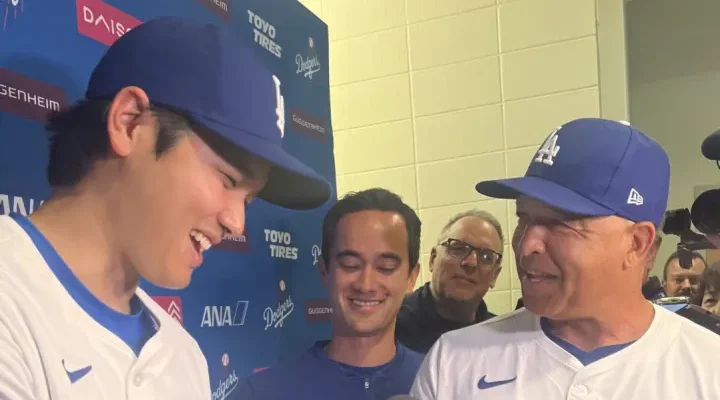Dodgers Manager Dave Roberts Gives Candid Insight on Shohei Ohtani’s Role Change and Its Impact on Team Dynamics
The Los Angeles Dodgers’ 2025 season has brought more than the usual challenges of competition, injuries, and divisional pressures—it has also sparked conversations about one of baseball’s most fascinating talents: Shohei Ohtani. The two-way phenom, known for his rare combination of pitching prowess and offensive dominance, has undergone a role change that has captured the attention of fans, analysts, and teammates alike. Dodgers manager Dave Roberts recently provided a candid assessment of Ohtani’s adjustment, offering insight into both the reasoning behind the shift and how it affects the team’s overall strategy.
Ohtani, who has consistently defied conventional baseball norms, has historically excelled as both a starting pitcher and a designated hitter. His ability to dominate on the mound while producing in the batter’s box has made him a unique challenge for opponents. However, balancing these dual responsibilities presents inherent risks, particularly regarding fatigue, injury, and peak performance management over the grueling 162-game season. The Dodgers’ coaching staff has approached this situation with careful consideration, aiming to maximize Ohtani’s impact while preserving his long-term effectiveness.
Dave Roberts acknowledged the complexities involved in managing a player of Ohtani’s caliber. “Shohei is unlike anyone I’ve ever managed,” Roberts explained. “His talent allows us to approach the game differently, but it also requires us to think strategically about how we use him so that we get the most out of him over the entire season.” This honesty highlights Roberts’ awareness of both the opportunities and challenges that come with utilizing Ohtani in multiple roles.
The role change itself reflects a combination of team needs and individual performance considerations. By adjusting Ohtani’s pitching schedule and sometimes limiting his time in the batter’s box, the Dodgers aim to ensure he remains effective and healthy throughout the season. This approach also allows the team to optimize lineup construction, giving other hitters opportunities while keeping Ohtani fresh for high-leverage situations. Analysts note that such decisions, while sometimes controversial among fans, are essential in balancing short-term performance with long-term sustainability.
Roberts emphasized that Ohtani’s flexibility is a key asset. “We’re fortunate that he can contribute in so many ways,” Roberts said. “Whether he’s pitching or hitting, he changes the dynamic of every game. It’s a challenge to find the right balance, but it’s also a unique advantage that very few teams have.” This perspective reflects a broader strategic approach, recognizing that managing a player with Ohtani’s skill set requires creativity and adaptability.
The adjustment has had ripple effects throughout the Dodgers’ roster. Other players have shifted roles, altered their routines, and embraced new responsibilities to accommodate the team’s evolving strategy. While this can create growing pains, Roberts noted that it also fosters a collaborative environment. “Players understand that Shohei brings something special,” he said. “They’re willing to adjust, and that willingness makes our lineup stronger as a whole.” This synergy demonstrates how elite talent can influence not just performance but team culture.
From an analytical standpoint, Ohtani’s dual role presents both challenges and opportunities. Metrics such as pitch efficiency, batting production, and recovery time must be monitored closely to prevent overuse and maximize output. The Dodgers’ staff has implemented rigorous monitoring systems, using data-driven insights to guide day-to-day decisions. Roberts highlighted the importance of integrating analytics with traditional coaching: “Numbers give us a roadmap, but intuition and experience help us make real-time decisions during games.”
Fans, naturally, are watching closely. The excitement surrounding Ohtani’s every at-bat and pitching start is unparalleled, and any change in his usage sparks widespread discussion. While some may question adjustments that limit his appearances, Roberts urged patience and perspective. “Our goal is to win games and protect Shohei’s career,” he said. “Sometimes that means making choices that aren’t obvious in the moment, but we believe it’s the best path for both him and the team.”
In addition to performance considerations, Roberts addressed the human element. Ohtani’s work ethic, professionalism, and adaptability make the transition smoother, but it still requires ongoing communication. “He’s incredibly committed to the team and to his own growth,” Roberts noted. “That mindset allows us to have open conversations about what’s best for him and the team.” This mutual respect highlights the importance of leadership and communication in managing superstar talent.
The Dodgers’ broader strategy benefits from Ohtani’s role change in multiple ways. Pitching rotations are more flexible, lineups can be optimized for situational matchups, and the team gains a psychological edge against opponents who must plan around Ohtani’s presence in both the batter’s box and on the mound. Roberts stressed that while adjustments may be subtle to casual observers, their cumulative effect can be decisive over the course of a long season.
Looking forward, Roberts indicated that the team will continue to evaluate Ohtani’s usage dynamically. “We’re always assessing performance, health, and team needs,” he explained. “Shohei’s role may evolve further as the season progresses, but the underlying principle remains: we want him contributing at the highest level without compromising his long-term health.” This approach underscores the delicate balance between leveraging a superstar’s talents and maintaining sustainability over time.
In conclusion, the Dodgers’ handling of Shohei Ohtani’s role change reflects both the complexity and opportunity of managing a generational talent. Dave Roberts’ candid insights reveal a thoughtful, strategic approach that prioritizes team success while safeguarding Ohtani’s exceptional abilities. As the 2025 season unfolds, how effectively the Dodgers integrate Ohtani’s dual contributions may prove decisive not only for individual games but for the team’s ultimate playoff aspirations. For fans and analysts alike, the process offers a compelling glimpse into the strategic considerations that define modern baseball at the highest level.



